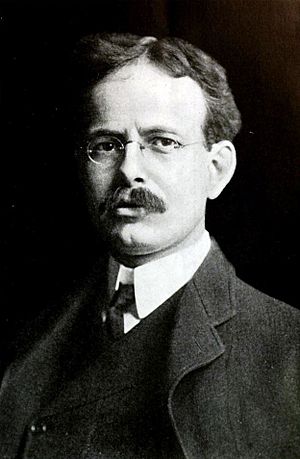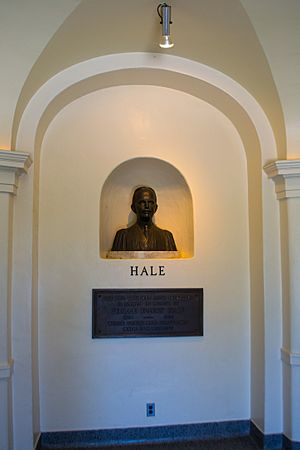George Ellery Hale facts for kids
Quick facts for kids
George Ellery Hale
|
|
|---|---|

George Ellery Hale, c. 1913
|
|
| Born | June 29, 1868 Chicago, Illinois, USA
|
| Died | February 21, 1938 (aged 69) Pasadena, California, USA
|
| Nationality | American |
| Alma mater | MIT |
| Known for | Spectroheliograph |
| Spouse(s) | Evelina Conklin Hale |
| Awards |
|
| Scientific career | |
| Fields | Astronomy Astrophysics |
| Institutions | University of Chicago, Carnegie Institution for Science, Caltech |
George Ellery Hale (born June 29, 1868 – died February 21, 1938) was an American astronomer. He is famous for studying the Sun and discovering magnetic fields in sunspots.
Hale was also a key person in building some of the world's most powerful telescopes. These include the 40-inch refracting telescope at Yerkes Observatory and the 60-inch and 100-inch reflecting telescopes at Mount Wilson Observatory. He also helped plan the 200-inch Hale reflecting telescope at Palomar Observatory. Beyond telescopes, he helped start important science groups like the International Union for Cooperation in Solar Research. He also played a big part in making the California Institute of Technology (Caltech) a top research university.
Contents
Early Life and Education
George Ellery Hale was born in Chicago, Illinois, on June 29, 1868. His parents were William Ellery Hale and Mary Browne. George was the oldest of three children who lived past childhood. His father, who made a lot of money from elevators, strongly supported George's curious mind. His mother taught him to love books and stories.
As a child, George loved the books and machines his parents gave him. A small microscope was one of his favorite things. With his father's help, he built a small workshop and laboratory at home. This microscope sparked his interest in how light and lenses work. When he was 14, George built his first telescope. His father later bought him a better one, which they put on their roof. Soon, George was taking pictures of the night sky and drawing sunspots.
George loved to read about the new field of astrophysics, which combines astronomy and physics. He enjoyed stories by Jules Verne, especially those about adventures in the mountains of California. He also liked normal boy activities like fishing, swimming, and biking. He spent summers in Madison, Connecticut, where he met his future wife, Evelina Conklin.
After finishing public school, George went to Allen Academy. There, he studied chemistry, physics, and astronomy. He also took classes at the Chicago Manual Training School to learn practical skills. A friend of his father, the architect Daniel Burnham, helped George learn about architecture and city planning. When he was 17, George decided to study at the Massachusetts Institute of Technology (MIT).
At MIT, George invented the spectroheliograph. This special tool helped him discover solar vortices, which are like swirling patterns on the Sun. He also studied at the Harvard College Observatory and in Berlin, Germany. Even though he didn't finish his PhD, he became a professor at the new University of Chicago.
Amazing Sun Discoveries
In 1890, George Hale started doing research at the Kenwood Astrophysical Observatory. His father had built this observatory just for him. He became a professor of astrophysics at Beloit College and later at the University of Chicago.
In 1908, Hale made a huge discovery about sunspots. He used a special method called the Zeeman effect with his spectroheliograph. This allowed him to prove that sunspots have strong magnetic fields. He found that these magnetic fields tend to line up east-west. They also had a mirror image pattern across the Sun's equator. Even more amazing, the direction of the magnetic field in each half of the Sun switched every 11 years. This pattern is now called "Hale's law."
Hale spent much of his career trying to take pictures of the Sun's outer atmosphere, called the solar corona. Normally, you can only see the corona during a total solar eclipse. However, he wanted to find a way to see it all the time. Another scientist, Bernard Lyot, later achieved this goal.
In 1913, the famous scientist Albert Einstein wrote to Hale. Einstein wanted to know if certain observations could be made to test his ideas about how gravity affects light. Hale replied that these observations could only be done during a total solar eclipse.
Building Great Observatories
George Hale was a very driven person. He worked hard to create many important astronomical observatories. These include the Yerkes Observatory, Mount Wilson Observatory, Palomar Observatory, and the Hale Solar Laboratory.
At Mount Wilson, he hired and encouraged two famous astronomers, Harlow Shapley and Edwin Hubble. They went on to make some of the biggest discoveries in astronomy at that time. Hale was also great at organizing. He helped create many astronomy groups, societies, and science journals. He also played a big part in making the California Institute of Technology (Caltech) a leading research university. After he stopped being the director at Mount Wilson, he built the Hale Solar Laboratory in Pasadena, California. This was his office and workshop, where he continued to study the Sun.
From a young age, Hale was interested in working with scientists from other countries. He traveled a lot in Europe when he was younger. He knew how important it was for scientists around the world to work together. As the head of a committee for the National Academy of Sciences in the US, he worked to create an international group for solar research.
The first meeting of this group was held in St. Louis in 1904. Scientists from 16 countries attended. They decided to create a permanent international science organization called the International Union for Cooperation in Solar Research. This new group had its first official meeting in Oxford, England, a year later. Later meetings were held in Paris and at Mount Wilson. At the Mount Wilson meeting, the group decided to include research on other stars, not just the Sun. This was because Hale believed the Sun was just one of many stars.
During World War I, Hale helped create the National Research Council. This group helped the government use science for its goals, especially for military purposes.
Personal Life
George Hale had some health problems, including trouble sleeping, frequent headaches, and feeling very sad. There is a common myth that he had schizophrenia and claimed an elf visited him. This story came from a misunderstanding by one of his biographers.
Because of his health issues, he had to step down as director of Mount Wilson. He passed away in Pasadena in 1938.
Honors and Awards
George Ellery Hale received many awards for his important work:
- 1894 Janssen Medal from the Paris Academy of Sciences
- 1902 Rumford Prize from the American Academy of Arts & Sciences
- 1904 Henry Draper Medal from the National Academy of Sciences
- 1904 Gold Medal of the Royal Astronomical Society
- 1916 Catherine Wolfe Bruce Gold Medal from the Astronomical Society of the Pacific
- 1917 Prix Jules Janssen from the French Astronomical Society
- 1919 Elected an associate of Académie des Sciences, Institut de France
- 1920 Galileo Medal from the University of Florence
- 1921 Actonian Prize from Royal Institution of London
- 1926 Elliott Cresson Medal in Physics from the Franklin Institute of Philadelphia
- 1926 Arthur Noble Medal from the City of Pasadena
- 1927 Franklin Medal from the Franklin Institute of Philadelphia
- 1932 Sir Godfrey Copley Medal from the Royal Society of Great Britain
- 1935 Frederic Ives Medal from the Optical Society of America
- Foreign Member of the Royal Society
- Medal of Merit of the Order of Leopold from Belgium
- Order of the Crown of Italy
- Honorary Member of the Vienna Academy of Sciences
Legacy
Many things are named after George Ellery Hale to honor his contributions:
- The 100 inch telescope at Mount Wilson Observatory
- The Hale telescope at Palomar Observatory
- The 22-year solar Hale cycle (a pattern in the Sun's magnetic activity)
- The 1024 Hale asteroid
- Mount Hale, a mountain in the Sierra Nevada
- Hale lunar crater on the Moon
- Hale Martian crater on Mars
- George Ellery Hale Middle School in California
- Hale House at the University of Chicago
- Hale Building in Pasadena, California
- The George Ellery Hale Prize, an award given by the Solar Physics Division of the American Astronomical Society
See also
 In Spanish: George Ellery Hale para niños
In Spanish: George Ellery Hale para niños


